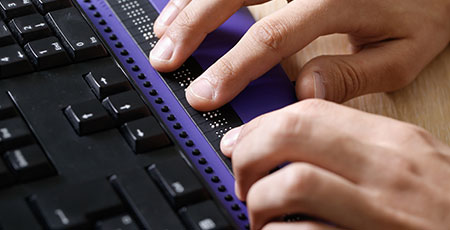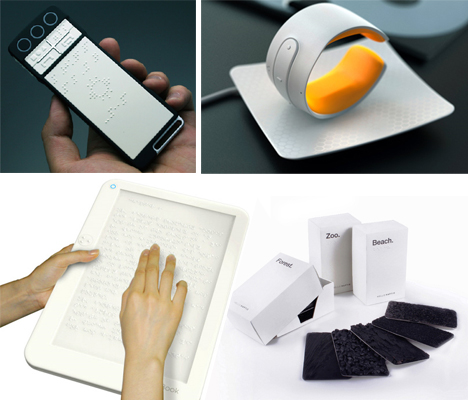Enhancing Lives With Advanced Assistive Tools for the Blind
The assimilation of innovative assistive tools for the blind is changing just how individuals experience their surroundings and interact with their communities. What does this advancement mean for the future of assistive technology and its role in empowering individuals?
Review of Assistive Instruments
Assistive gadgets for the blind encompass a diverse variety of tools and innovations made to improve freedom and enhance the lifestyle for people with aesthetic impairments. These tools accommodate various demands, from navigating and wheelchair to interaction and everyday task monitoring.
Among the primary categories of assistive tools includes flexibility aids, such as white walking sticks and overview pets, which help individuals browse their environments safely. Electronic traveling aids, equipped with sensing units and audio feedback, additionally play a significant role in flexibility enhancement.
Furthermore, gadgets that aid with day-to-day living activities, such as adaptive kitchen area devices, Braille tags, and talking watches, equip people to carry out jobs individually. Interaction help, consisting of display visitors and Braille display screens, facilitate accessibility to details and make it possible for people to involve properly with the electronic globe.
Additionally, low-tech solutions like amplifying glasses and large-print products stay essential for many customers. Jointly, these assistive gadgets serve not just as practical devices yet also as important enablers of freedom, promoting greater participation in a globe that frequently focuses on sighted experiences. Their assimilation into life is crucial for promoting inclusivity and boosting overall health for those with aesthetic disabilities.
Ingenious Technologies in operation
Advancement in technology has substantially changed the landscape of tools available for individuals with visual disabilities. Amongst one of the most noteworthy developments are wise glasses integrated with enhanced reality, which offer real-time navigation assistance and object recognition. These tools leverage progressed cameras and expert system to provide acoustic cues, improving the customer's spatial awareness and freedom.
Furthermore, mobile applications have become powerful resources, enabling users to recognize money, checked out text out loud, and navigate strange environments via spoken directions. Devices such as Braille screens and refreshable Braille gadgets proceed to evolve, supplying seamless connectivity with computer systems and smart devices, thus boosting communication and access to info.
Wearable technology, consisting of smartwatches geared up with voice-activated functions, additionally encourages individuals by facilitating quick accessibility to notices and alerts without calling for visual engagement. Tactile maps and 3D printing are additionally obtaining traction, offering tangible representations of rooms that help in alignment and wheelchair training.
Collectively, these ingenious modern technologies not only improve the lives of aesthetically impaired people however likewise foster better self-reliance, inclusivity, and involvement with the more comprehensive neighborhood, thereby improving understandings of ease of access. (Voice-activated assistive devices)
Individual Stories of Empowerment
Empowerment frequently emerges from personal experiences that highlight the transformative impact of modern technology on individuals with visual problems. Take, as an example, the tale of Sarah, a young musician who restored her enthusiasm for painting with the usage of a clever walking cane geared up with challenge discovery. This tool not only facilitated her wheelchair yet instilled a newly found self-confidence, permitting her to navigate public areas individually and seek her creative endeavors.

These narratives underscore the extensive effects that progressed assistive gadgets can carry everyday life. By allowing people to get over barriers, technology fosters a sense of autonomy and self-respect. Such empowerment stories function as a testament to the capacity of development, showing exactly how the right devices can significantly boost lifestyle and open doors to new possibilities for those with visual impairments.
Benefits of Advanced Solutions
Exactly how can advanced services fundamentally enhance the lives of people with aesthetic problems? The combination of innovative innovation into assistive devices dramatically changes daily experiences for those affected by vision loss. These sophisticated services offer unprecedented freedom, enabling customers to navigate their settings with confidence. Tools such as wise canes equipped with sensors, navigating applications, and wearable innovation are developed to provide real-time feedback, improving spatial understanding and minimizing the threats related to mobility.
Additionally, advanced assistive technologies cultivate social inclusion by assisting in interaction and interaction. Voice-activated gadgets and applications permit people to access info and involve with their environments individually, breaking obstacles that formerly prevented their participation in academic, professional, and social settings.
Furthermore, the modification and versatility of these remedies satisfy the diverse needs of users, thus enhancing their total lifestyle. Boosted capability, such as item recognition and text-to-speech capabilities, empowers individuals with visual impairments to carry out tasks that they may have as soon as located testing. Ultimately, advanced assistive modern technologies not just enhance independence and security but additionally promote self-respect and self-worth, allowing customers to lead meeting lives.
Future Patterns in Assistive Tech
As technology remains to evolve, the landscape of assistive internet gadgets for the blind is poised for impressive improvements that will even more enhance ease of access and self-reliance. Emerging trends in assistive modern technology show a change toward increased integration of expert system (AI) and artificial intelligence, enabling gadgets to adjust to private customer requires in real-time. These developments are expected to assist in more instinctive navigating systems that can identify barriers and give audio responses, dramatically improving exterior wheelchair.
Furthermore, the development of wearable tech, such as clever glasses geared up with augmented truth, will certainly enable individuals to receive contextual info about their environments, thus improving their spatial understanding. Developments in haptic innovation pledge to develop responsive feedback devices, enabling customers to regard information through touch, enhancing discovering and interaction with their atmosphere.
Telecommunication developments are likewise paving the way for remote support remedies, where qualified experts can supply advice using video clip phone calls, making sure support is readily available. As these patterns unfold, the future of assistive gadgets for the blind will most certainly foster greater freedom, equipping individuals to navigate their world with self-confidence and ease.

Verdict
The assimilation of sophisticated assistive tools for the blind stands for a substantial Your Domain Name advancement in promoting freedom and enhancing top quality of life. By utilizing cutting-edge innovations, these tools equip individuals to browse their settings with greater self-confidence and autonomy. As the field continues to progress, recurring r & d will likely yield much more advanced options, further transforming the lived experiences of individuals with aesthetic disabilities and promoting a greater feeling of addition within culture.
The integration of innovative assistive devices for the blind is transforming exactly how people experience their environments and engage with their neighborhoods. The combination of sophisticated technology right into assistive gadgets dramatically changes daily experiences for those affected by vision loss.As modern technology continues to evolve, the landscape of assistive devices for the blind is positioned for exceptional developments that will certainly further enhance access and independence. Arising trends in assistive technology show a shift toward increased combination of synthetic knowledge (AI) and device understanding, making it possible for gadgets to adjust to private customer needs in real-time.The combination of innovative assistive devices for the blind stands for a considerable improvement in cultivating independence and enhancing top quality of life.
Comments on “Voice-Activated Assistive Devices: Simplifying Regular Tasks”